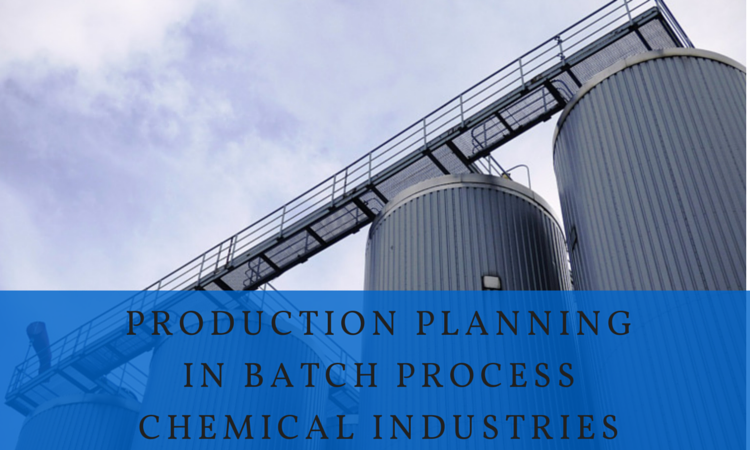Production planning in a chemical industry can be best done using the Agile methodology having modular and iteration options at every stage. Being a Software and a Chemical business entrepreneur for over two decades, I am easily able to see many similarities in both the processes. In this post, I would be sharing the method of production planning in a chemical unit, using the agile process, which is fairly common in the software industry.
The chemical, technical and business processes of different industries are quite diverse and different from each other. However, from the viewpoint of production scheduling and inventory planning, there are some key aspects that are common in the process. These aspects are also relevant in various other industries:
1. Changeover and Sequencing:
Process plant productivity is very sensitive to product transitions. It is important to properly sequence these transitions in order to improve yields and reduce the changeovers. Cleanup costs should be taken into account. When planning product mix and sequencing, the product wheels and changeover matrices provide a critical planning criteria.
2. Tanks or Silos:
Inventory and work-in-process materials are stored in tanks or silos. Planning for production in tanks and silos not only addresses the time required for the operation, but also the volume of the material. The inflow from one operation and the outflow from the other dictate when a tank is prepared and available. The upstream and downstream operations should be scheduled synchronously to ensure that the tank does not overflow.
To make the discussion more relevant we will take a practical case and list out the facilities.
Be it any industry or business sector, the facilities are generally similar in most of the manufacturing units. Every manufacturing facility has a plant/plants in one or more buildings (Say A and B). In both the buildings, two production lines are available for manufacturing. Most of the products are manufactured on the production line of the building A. Whereas only a small amount of production is possible in the building B.
The planning of the production plant is critically impacted by the production batch sizes. The production takes place in fixed batch sizes in all the production lines. In some units, the batch sizes also vary and in some they don’t. This variable should be integrated into the algorithm to get the optimum production schedule.
There exists one major difference between the layouts of the production lines in the two buildings. The production lines in building B start as two parallel lines but share a single division at the end of the production process, known as Packing Division. Between the production of two different products, this facility has to be cleaned and thus, set up times are incurred.
At the moment a replenishment order is placed, care is to be taken that there is sufficient space available in the tank. If required space is not available in the tank, the complete line is blocked and production capacity of that line becomes underutilized.
The demand for the manufactured products is highly uncertain in the market. But sometimes, the products are requested to be delivered at a short notice. In order to avoid small production runs and high frequency of set ups, it is prudent to batch the current and future demands for a particular product.
When several batches for a particular product are combined in one production run, it is called sequence. Raw materials available for production, always come in large quantities. For now, we are assuming that all the materials are kept in stock, in the manufacturing facility.
Finally, since the shelf life of the products is sufficiently long, they can be considered as non-perishable goods. A due date is set for each batch of orders which results from an agreement between the sales team and the production team. Previous orders that were not executed, are added to the current orders and are included in the production.
Workflow softwares can easily predict the optimum utilization of the resources. A workflow software is recommended to be used for planning the complete utilization of employed resources. In the present project, we can obtain the inventory requirements so that given quality-of-service levels can be met.
3. Planning Methodology:
The planning methodology is done on a daily basis and it consists of two parts. Firstly, the replenishment orders are placed by the Sales team. The inventory position is defined as the physical inventory plus, the stock on order minus, the back-orders.
Secondly, the production people assign these replenishment orders to the production lines and determine the sequence of production. These allocation and sequencing decisions are based on experience and future expectations.
The above planning methodology has been studied before in the open literature by approximate analytic models and deploying restrictive assumptions. Looking for an analytical method to compute the performance of the system are used with these restrictive assumptions.
4. Previous Records:
The Algorithm can have an interface that will auto-update the previous production records and include artificial learning process. It will assign values to the parameters included. The algorithm will modify the process as it starts getting more and more records into the system. If required, a provision can be made to feed the older records that were processed and formulated before the algorithm was put in place.
5. Stockout Reports:
This is a major problem that occurs in industries where there is a large product range and a batch production process. Keeping inventory of all the materials is costly for every business business. And not having a product available when there is a demand is a loss of opportunity for the business.The algorithm can account for such products and can treat them differently. It ensures optimum profits for the business by maintaining ideal production cycles at correct times.
Algorithms, Data-Processing, Cloud-Computing, Mobile Access, etc. have now made so many options possible for the manufacturing businesses. Appropriate measures and utilization of new softwares are required to be done, depending upon the size of operations and the value of benefits derived.
Given the above information, it is easy to develop a fast, accurate and easy-to-implement algorithm. The algorithm can help with evaluation and optimization of batch-production/inventory systems.
This algorithm should have provision for making suitable alterations. At the same time, it should ensure minimum down time in the production lines. Furthermore, the algorithm should be applicable in the situation of multiple parallel identical production lines. It should be able to compute a wide range of performance measures. The implemented algorithm will ease and simplify the Production planning process.

